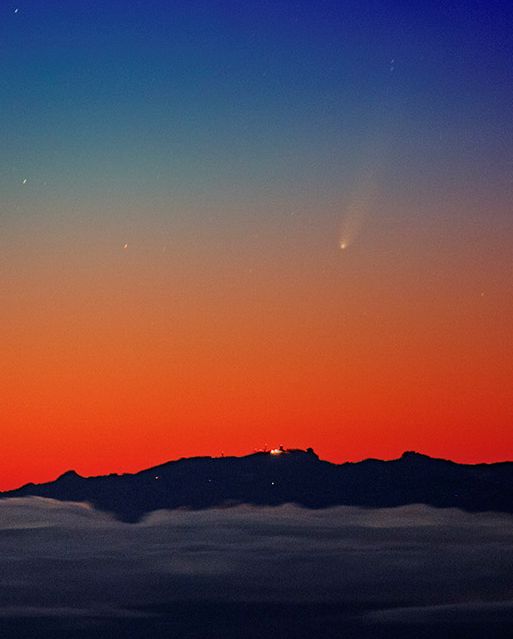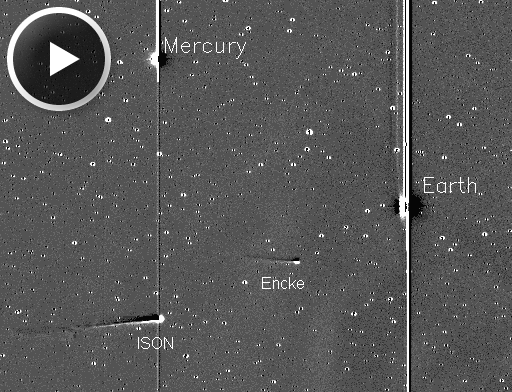Listen to radar echoes from satellites and meteors, live on listener-supported Space Weather Radio. | | |
WHAT HAPPENS IF A SOLAR STORM HITS COMET ISON? On Nov. 28th, Thanksgiving Day in the USA, Comet ISON will swoop through the sun's atmosphere little more than a million kilometers above the sun's fiery surface. What might happen if, at that moment, Comet ISON gets hit by a solar storm? Experts discuss the answer in today's story from Science@NASA. Solar flare alerts: text, voice
COMET ISON, PARTING SHOTS: As Comet ISON approaches the sun, it is becoming increasingly difficult for observers on Earth to photograph the comet. Indeed, by Nov. 24th it seemed impossible. But it only seemed that way. Working from a high-altitude site in the Canary islands, Juan Carlos Casado successfully imaged Comet ISON on Sunday morning deep inside the rosy glow of dawn:

"I took this picture of Comet ISON on Nov. 24th at 6: 25 UT from the Teide Observatory," says Casado. "The comet was over the distant island of Gran Canaria above a sea of clouds about 1 hour before sunrise and only 16° from the sun. The exceptional atmospheric conditions of Teide Observatory allowed me to capture the image."
Could this be the last clear photo of Comet ISON taken from Earth? No one knows. Stay tuned to the realtime photo gallery for more parting shots:
Realtime Comet ISON Photo Gallery
COMETS IN THE SOLAR WIND: NASA's STEREO-A spacecraft is monitoring Comet ISON as it approaches the sun. The latest movie from the spacecraft's Heliospheric Imager captures not only Comet ISON but also Earth, Mercury, and Comet Encke. Click to set the scene in motion:

In the movie, which spans a two+ day period from Nov. 20 to Nov. 22, the sun is to the right, off-screen. "The dark 'clouds' coming from that direction are density enhancements in the solar wind, and these are what are causing the ripples you see in the comet tails," explains Karl Battams of NASA's Comet ISON Observing Campaign.
Although the two comets seem to be experiencing the same solar wind, their tails ripple differently. "Encke has kind of long waves in the tail, whereas ISON's seems almost like high-frequency puffs," points out Battams.
Appearances notwithstanding, the two comets might be in two different streams. "The most likely explanation is that ISON is in a faster stream of solar wind," he continues. "Imagine holding a flag on a slightly breezy day. The flag will waft gently in the breeze. Now imagine holding it in really strong winds. The flag will be rippling violently, but those ripples will be smaller in amplitude."
Battams also suggests a second, more speculative possibility for the difference. You can read about it here. And stay tuned for more images from NASA's solar fleet.
Realtime Comet ISON Photo Gallery
Realtime Space Weather Photo Gallery
Realtime Aurora Photo Gallery
Every night, a network of
NASA all-sky cameras scans the skies above the United States for meteoritic fireballs. Automated software maintained by NASA's Meteoroid Environment Office calculates their orbits, velocity, penetration depth in Earth's atmosphere and many other characteristics. Daily results are presented here on Spaceweather.com.
On Nov. 23, 2013, the network reported 6 fireballs.
(6 sporadics)

In this diagram of the inner solar system, all of the fireball orbits intersect at a single point--Earth. The orbits are color-coded by velocity, from slow (red) to fast (blue). [Larger image] [movies]
Potentially Hazardous Asteroids (
PHAs) are space rocks larger than approximately 100m that can come closer to Earth than 0.05 AU. None of the known PHAs is on a collision course with our planet, although astronomers are finding
new ones all the time.
On November 24, 2013 there were potentially hazardous asteroids.
Notes: LD means "Lunar Distance." 1 LD = 384,401 km, the distance between Earth and the Moon. 1 LD also equals 0.00256 AU. MAG is the visual magnitude of the asteroid on the date of closest approach. | | The official U.S. government space weather bureau |
| | The first place to look for information about sundogs, pillars, rainbows and related phenomena. |
| | Researchers call it a "Hubble for the sun." SDO is the most advanced solar observatory ever. |
| | 3D views of the sun from NASA's Solar and Terrestrial Relations Observatory |
| | Realtime and archival images of the Sun from SOHO. |
| | from the NOAA Space Environment Center |
| | the underlying science of space weather |

